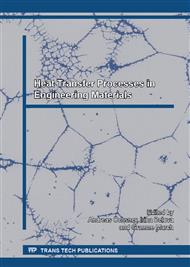[1]
R. Loison, P. Foch and A. Boyer. Le coke, Dunod (1970), pp.59-68.
Google Scholar
[2]
S. Ben Nasrallah and P. Perré. Detailed study of a model of heat and mass transfer during convective drying of porous media. Int. J. Heat Mass Transfer 31(5) (1988), pp.957-967.
DOI: 10.1016/0017-9310(88)90084-1
Google Scholar
[3]
O.A. Plumb, G.A. Spolek and B.A. Olmstead. Heat and mass transfer in wood during drying. Int. J. Heat Mass Transfer, 28(9) (1985), pp.1669-1678.
DOI: 10.1016/0017-9310(85)90141-3
Google Scholar
[4]
Y. Zhang, X.F. Peng and I. Conte. Heat and mass transfer with condensation in non saturated porous media, Numer. Heat Transfer, Part A: Appl. 52 (12) (2007), p.1081–1100.
DOI: 10.1080/10407780701453800
Google Scholar
[5]
S. Chemkhi. Séchage d'un milieu déformable non saturé: modélisation du couplage hygromécanique, PhD of University of Bordeaux 1 (2008).
Google Scholar
[6]
A. Halder, A. Dhall and A.K. Datta. Modelling transport in porous media with phase change: Applications to food processing, Journal of Heat Transfer, March 2011, Vol. 133 / 031010-1.
DOI: 10.1115/1.4002463
Google Scholar
[7]
V.A. Luikov. Theory of Drying (in Rusian) (1968). Energija, Moskva.
Google Scholar
[8]
V.A. Luikov. Handbook of Heat and Mass Transfer (in Rusian) (1972). Energija, Moskva.
Google Scholar
[9]
S. Whitaker. Simultaneous heat, mass and momentum transfer in porous media: a theory of drying. Advances in heat transfer, 1977, Vol. 13, Academic Press, New York, pp.119-203.
DOI: 10.1016/s0065-2717(08)70223-5
Google Scholar
[10]
G.N. Ahmed and J.P. Hurst. Coupled heat and mass transport phenomena in siliceous aggregate concrete slabs subjected to fire, Fire Mater. 21 (4) (1997), p.161–168.
DOI: 10.1002/(sici)1099-1018(199707/08)21:4<161::aid-fam602>3.0.co;2-r
Google Scholar
[11]
D. Gawin, C.E. Majorana and B.A. Schrefler. Numerical analysis of hygro–thermal behaviour and damage of concrete at high temperature, Mech. Cohesive frictional Mater. 4 (1) (1999), p.37–74.
DOI: 10.1002/(sici)1099-1484(199901)4:1<37::aid-cfm58>3.0.co;2-s
Google Scholar
[12]
W.T. Simpson and J.Y. Liu. An optimization technique to determine red oak surface and internal moisture transfer coefficients during drying. Wood Fiber Sci., 29(4) (1997) pp.312-318.
Google Scholar
[13]
A.J. Hunter. An analytic model for air drying of impermeable wood. Wood Sci. Technol., 27 (2001), pp.127-131.
Google Scholar
[14]
A.V. Luikov. Heat and mass transfer in capillary-porous bodies. Pergamon Press, New York (1966), p.523.
DOI: 10.1002/aic.690130305
Google Scholar
[15]
N.E. Edlefsen and A.B.C. Anderson. Thermodynamics of soil moisture. Hilgardia, 15(2) (1943), pp.31-298.
DOI: 10.3733/hilg.v15n02p031
Google Scholar
[16]
P.F Low. Force fields and chemical equilibrium in heterogeneous systems with special reference to soils. Soil Sci., 71(6) (1951), pp.409-418.
DOI: 10.1097/00010694-195106000-00002
Google Scholar
[17]
P. Perré and I. Turner. Determination of the material property variations across the growth ring of softwood for use in a heterogeneous drying model. Part 1 Capillary Pressure, Tracheid Model and Absolute Permeability. Holzforschung 55(3) (2001), pp.318-323.
DOI: 10.1515/hf.2001.052
Google Scholar
[18]
P. Perré and I. Turner. Determination of the material property variations across the growth ring of softwood for use in a heterogeneous drying model. Part 2 Use of homogenisation to predict bound. Holzforschung 55(3) (2001), pp.318-323.
DOI: 10.1515/hf.2001.069
Google Scholar
[19]
C.A. Aumann and E.D. Ford. Modeling tree water flow as an unsaturated flow through a porous medium. J. theor. Biol. 219 (2002), pp.415-429.
DOI: 10.1006/jtbi.2002.3061
Google Scholar
[20]
O. Coussy. Mechanics and physics of porous solids, Wiley, 2010.
Google Scholar
[21]
B. Weber. Heat transfer mechanisms and models for a gypsum board exposed to fire, International Journal of Heat and Mass Transfer, Vol. 55, Issues 5-6 (2012), p.1661–1678.
DOI: 10.1016/j.ijheatmasstransfer.2011.11.022
Google Scholar
[22]
S. Whitaker. Coupled transport in multiphase systems: A theory of drying, Advances in heat transfer, Vol. 31 (1998), pp.1-104.
DOI: 10.1016/s0065-2717(08)70240-5
Google Scholar
[23]
C.V. Le, N.G. Ly and R. Postle. Heat and mass transfer in the condensing flow of steam through an absorbing fibrous medium, Int. J. Heat and Mass Transfer, 38(1) (1995), pp.81-89.
DOI: 10.1016/0017-9310(94)00139-m
Google Scholar
[24]
F. Scarpa and G. Milano. The role of adsorption and phase change phenomena in the thermophysical characterization of moist porous materials, Int. J. Thermophys., Vol 23, Issue 4 (2002), pp.1033-1046.
Google Scholar
[25]
C.A. Ward and G. Fang. Expression for predicting liquid evaporation flux: Statical rate approach, Phys. Rev. E, Vol. 59, Issue 1 (1999), pp.429-440.
DOI: 10.1103/physreve.59.429
Google Scholar
[26]
J. Rhode and A. Jeppsson. Literature review of heat treatment simulations with respect to phase transformation, to residual stresses and distortion, Scandinavian Journal of Metallurgy; Vol. 29, Issue 2 (2000), pp.47-62.
DOI: 10.1034/j.1600-0692.2000.d01-6.x
Google Scholar
[27]
J.Tomeczek and H.Palugniok, Specific heat capacity and enthalpy of coal pyrolysis at elevated temperatures, Fuel, Vol. 75, No 9 (1996), pp.1089-1093.
DOI: 10.1016/0016-2361(96)00067-1
Google Scholar
[28]
T. Rozhkova, Measurement of the plastic phase properties and gas pressure generation by advanced testing equipments, Report of Centre de Pyrolyse de Marienau (France), 2012.
Google Scholar


